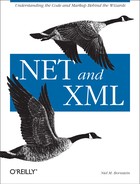Reading Data Into a DOM Tree
There’s another way to
read XML directly from a database. The
XmlDataDocument, which extends
XmlDocument, presents the contents of a
DataSet as an XML document. At that point, the
data can be treated just like any other
XmlDocument, including navigating to specific
nodes with XPath, writing it to any sort of
Stream, transforming it with XSLT, and in fact any
of the other techniques I’ve shown you in this book.
Example 11-11 shows a program that executes the same
query from example 11-10 and writes the resulting XML to the console.
using System;
using System.Data;
using System.Data.SqlClient;
using System.Xml;
public class ReadDataAsXml {
public static void Main(string [ ] args) {
DataSet dataSet = new DataSet("AngusHardware");
SqlConnection connection = new SqlConnection(
"Initial Catalog=AngusHardware; User ID=sa");
string command = "SELECT name, redemption_date, total_discount " +
"FROM coupon_redemptions a, customers b " +
"WHERE a.customer_id = b.customer_id";
SqlDataAdapter adapter = new SqlDataAdapter(command, connection);
adapter.Fill(dataSet, "CouponsRedeemed");
XmlDataDocument doc = new XmlDataDocument(dataSet);
XmlTextWriter writer = new XmlTextWriter(Console.Out);
writer.Formatting = Formatting.Indented;
doc.WriteTo(writer);
}
}You’ve seen most of this before, but
here’s a quick look at some of the more important
steps. First, you create the DataSet, the
SqlConnection, a SQL select command, and the
SqlDataAdapter:
DataSet dataSet = new DataSet("AngusHardware");
SqlConnection connection = new SqlConnection(
"Initial Catalog=AngusHardware; User ID=sa");
string command = "SELECT name, redemption_date, total_discount " +
"FROM coupon_redemptions a, customers b " +
"WHERE a.customer_id = b.customer_id";
SqlDataAdapter adapter = new SqlDataAdapter(command, connection);Next, you fill the adapter with data, naming the
DataTable
“CouponsRedeemed”:
adapter.Fill(dataSet, "CouponsRedeemed");
Now, create an XmlDataDocument to wrap the
DataSet. After this, doc is now
ready to use, including all the base XmlDocument
members:
XmlDataDocument doc = new XmlDataDocument(dataSet);
In this case, you can just use an XmlWriter to
output the XmlDataDocument to the console:
XmlTextWriter writer = new XmlTextWriter(Console.Out); writer.Formatting = Formatting.Indented; doc.WriteTo(writer);
Other options include doing some sort of XPath query:
XmlNodeList nodes = doc.SelectNodes("//total_discount");
foreach (XmlElement element in nodes) {
Console.WriteLine("Total discount is {0}", element.InnerText);
}
Unlike the XmlReader,
the DataSet is a disconnected view of the data in
the database. Once the DataSet is populated, you
won’t use up a database connection, so you can do as
much with the DataSet as you want. The flip side
of that is that all the data are stored locally, so large databases
can use a lot of local storage.
